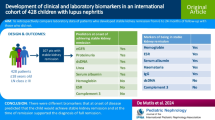Summary
In order to analyze the cai]ses of delayed diagnosis and raise the level of early diagnosis of atypical multiple myeloma (MM), the differences of presenting features between the patients presented to nephrologists and those presented to hematologists were compared. MM patients in our hospital were studied retrospectively. Those who referred renal impairment were divided into two groups: group I presented to nephrologists prior to MM diagnosis (n=29) and group II presented to hematologists directly (n=62). The age, sex, initial symptoms, haematological and biochemical parameters, the phenotype of paraprotein, bone marrow biopsy and cytology were undertaken and analyzed. The results showed that the median time between the initial symptoms and diagnosis in the patients of group I was longer than that in group II (P<0.001); patients in group I had significantly lower incidence of bone pain (P<0.01) and worse renal function (P<0.05) on presentation. There were lower level of myeloma cells (P<0.05), lower incidence of hypergammaglobulinemia (P<0.05), lower positive rate of monoclonal immunoglobulin (M protein) (P<0.05) and M protein level (P<0.05) in the patients of group I than those in group II. The ratio of monoclonal to lambda monoclonal proteins in a population was 1:3.67 in patients of group I, whereas 1:0.90 in patients of group II (P<0.01). Moreover, patients with λ type had a higher degree of renal insufficiency than those with κ type (P<0.05). It was suggested that the median time between the initial symptoms and diagnosis in the patients presented to nephrologists was longer than that in those presented to hematologists; the patients presented to nephrologists had the lower incidence of bone pain, lower level of myeloma cells and M protein, which made early diagnosis more difficult; more patients presented to nephrologists had the majority of λ light chain type, moreover, patients with λ light chain type had a higher incidence of renal insufficiency.
Similar content being viewed by others
References
Huang SY, Yao M, Tang JL, et al. Epidemiology of multiple myeloma in Taiwan: increasing incidence for the past 25 years and higher prevalence of extramedullary myeloma in patients younger than 55 years. Cancer, 2007,110(4):896–905
Kyle RA, Gertz MA, Witzig TE, et al. Review of 1027 patients with newly diagnosed multiple myeloma. Mayo Clin Proc, 2003,78(1):21–33
Blade J, Fernandez-Llama P, Bosch F, et al. Renal failure in multiple myeloma presenting features and predictors of outcome in 94 patients from a single institution. Arch Intern Med, 1998,158(17):1889–1893
Irish AB, Winearls CG, Littlewood T. Presentation and survival of patients with severe renal failure and myeloma. QJM, 1997,90(12):773–780
Knudsen LM, Hjorth M, Hippe E. Renal failure in multiple myeloma:reversibility and impact on the prognosis. Eur J Haematol, 2000,65(3):175–181
International Myeloma Working Group. Criteria for the classification of monoclonal gammopathies, multiple myeloma and related disorders: a report of the International Myeloma Working Group. Br J Haematol, 2000,121(5):749–757
Clark AD, Shetty A, Soutar R. Renal failure and multiple myeloma: pathogenesis and treatment of renal failure and management of underlying myeloma. Blood Rev, 1999,13(2):79–90
Eleutherakis-papaiakovou V, Bamias A, Gika D, et al. Renal failure in multiple myeloma: Incidence, correlations, and prognostic significance. Leuk Lymphoma, 2007,48(2):337–341
Chan DT, Craig K, Donovan K, et al. Myeloma renal disease: presentation and outcome. Nephron Clin Pract, 2006,104(3):c126–131
Liu XM, Xu JL, Guan XH, et al. Clinical features of renal insufficiency due to multiple myeloma and related risk factors. Chin German J Clin Oncol, 2005,4(1):47–49
Sengul S, Zwizinski C, Batuman V. Role of MAPK pathways in light chain-induced cytokine production in human proximal tubule cells. Am J Physiol Renal Physiol, 2003,284(6):1245–1254
Hata H. Bone lesions and macrophage inflammatory protein-1 alpha (MIP-1a) in human multiple myeloma. Leuk Lymphoma, 2005,46(7):967–972
Zhou ZH, Luo SK, Li J, et al. The relation between Bence-Jones protein gene polymorphism and function of renal tubular-epithelial cell in multiple myeloma. Zhonghua Nei Ke Za Zhi (Chinese), 2005,44(9):677–680
Leboulleux M, Lelongt B, Mougenot B, et al. Protease resistance and binding of Ig light chains in myeloma-associated tubulopathies. Kidney Int, 1995,48(1): 72–79
Author information
Authors and Affiliations
Corresponding author
Rights and permissions
About this article
Cite this article
Li, N., Lv, Y., Zeng, H. et al. Renal impairment in multiple myeloma: Presenting features in different departments. J. Huazhong Univ. Sci. Technol. [Med. Sci.] 32, 65–68 (2012). https://doi.org/10.1007/s11596-012-0011-0
Received:
Published:
Issue Date:
DOI: https://doi.org/10.1007/s11596-012-0011-0




